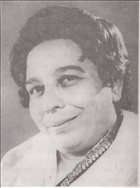


Strange are the vicissitudes of life, especially the ups and downs in the world of showbiz that those artistes who used to bask in the sunshine of glory, glamour and fame, were forgotten soon after their eclipse from the chart of popularity.
Ever since the advent to talkies (sound motion pictures) in the sub-continent, many heart-throbs of the millions have now slipped into historical oblivion, and very few among music buffs remember those glittering stars of yesteryears whose glow once brightened the entire firmament of showbiz.
Vocalist Shamshad Begum, whose sparkling melodies used to cast hypnotic spells on music buffs and movie-goers some 35 years ago, in now languishing in the murk of obscurity in a Bombay suburb. Forgotten by the movie moghuls, composers and cine-goers, the septuagenarian crooner is spending the evening of her life almost unnoticed.
Shamshad Begum ruled the roost, first at Lahore and later at Bombay, when Lata Mangeshkar and Asha Bhonsle were not even introduced in the film-world. She was the first female singer who assumed the status of a legend during her lifetime. With the help of her highly individualistic and charismatic personality, glow and a certain vivacity in her voice, she became the most sought-after female playback singer in the late 30s, 40s and 50s.
It was on Dec 16, 1937, when radio made its debut from Lahore and so did Shamshad Begum. Singing solos and duets with Umrazia Begum (who later became Mrs. Ghulam Haider), the Amritsar-born Shamshad Begum captivated the hearts of listeners with the enchanting depth of her voice which then had no parallel.
When she was in her teens, she shifted from Amritsar to Lahore where she soon became the first playback singer ever to lend her voice for the movies produced in Lahore. The then AIR Lahore helped her in penetrating the world of movies as frequent broadcasting of her songs induced music directors to use her voice for film songs. Shamshad Begum also recorded naats and devotional songs for a couple of gramophone recording companies which where then located in Bakshi Market of Anarkali, Lahore.
Lahore-based composer Ghulam Haider used her voice skillfully in some of his earlier films, mostly in Punjabi. The songs "Kankaan deyaan faslaan pakkiaan nain", when recalled, still create nostalgic fondness among senior denizens. Another composition of Master Ghulam Haider for which Shamshad Begum lent her voice was a "aya, hai bulaawa mujhe darbar-e-nabi se", which became very popular in the late 30s.
When the late Masterji shifted to Bombay in 1944, Shamshad Begum went with him as a member of his team. Both of them rose to heights of fame in the film capital of India. In 1944, when Mehboob Khan launched his historical venture, "Humayun", Shamshad Begum's voice was used by Master Ghulam Haider for the recording of that movie's songs. The song "nainaan bhar aaye neer" sung by Shamshad became a superhit.
That was the time when Amirbai Karnataki was considered number one playback singer in Bombay, and a majority of actresses used to croon songs picturised on them. With the introduction of Shamshad Begum in the filmworld in Bombay, contemporary composers almost fell over each other in booking her for the recording of their songs.
For almost three decades, Shamshad Begum reigned supreme in the world of film music in the subcontinent. Frontline composers like Master Ghulam Haider, Naushad Ali, O.P.Nayyar, C. Ramachandra used Shamshad Begum's voice which was then regarded as one of the guarantees for the success of a film.
The stark, almost unbearably tender "Ek tera sahara" (Ghulam Haider in the film "Shamaa"), the buoyant sophistication of the song "Nainaa bhar aye neer" (Master Ghulam Haider in "Humayun"), the open sadness of the song "Duniya badal gayi" (Naushad Ali in "Babul), the sparkling vivacity of "Kajra mohabbat wala" (O P Nayyar in "Qismat"), and the pathetic beseeching of a lover in "Ye afsaana nahi zaalim" (Naushad Ali in "Dard") are some of the extremely poignant reminders of Shamshad Begum's sonic versatility. Her other popular songs included "Kabhi aar kabhi paar laaga teer-e-nazar", "Reshmi salwar kudtaa jaali ka", "Bachpan ke din bhula na dena", "Chaman mein rahkar bhi", which still retain their freshness. With the wide range of her voice, Shamshad's command over her vocal resources sounded complete
Cinemasangeet Editor’s comments:
(The article was originally archived on RMIM page by Satish Subramanian.)